Strawberry pests – expert tips on how to spot them so you can protect your plants
How to identify and deter the most common strawberry pests


Strawberries are a crop that face a plethora of pests that want to attack plants and nibble on your precious fruits, potentially ruining any harvest.
Ranging from larger mammals to tiny aphids, there is quite a list of unwanted pests that could cause problems for your crops. It requires a close eye to be kept on strawberry plants and, if you want the best harvest possible, you’ll need to act quickly to deal with them.
There is no doubt that growing strawberries is a fantastic way of discovering and enjoying the wide range of varieties there are to grow at home. All the pests aside, they can be simple to grow and there are measures to combat many of the most common strawberry pests.
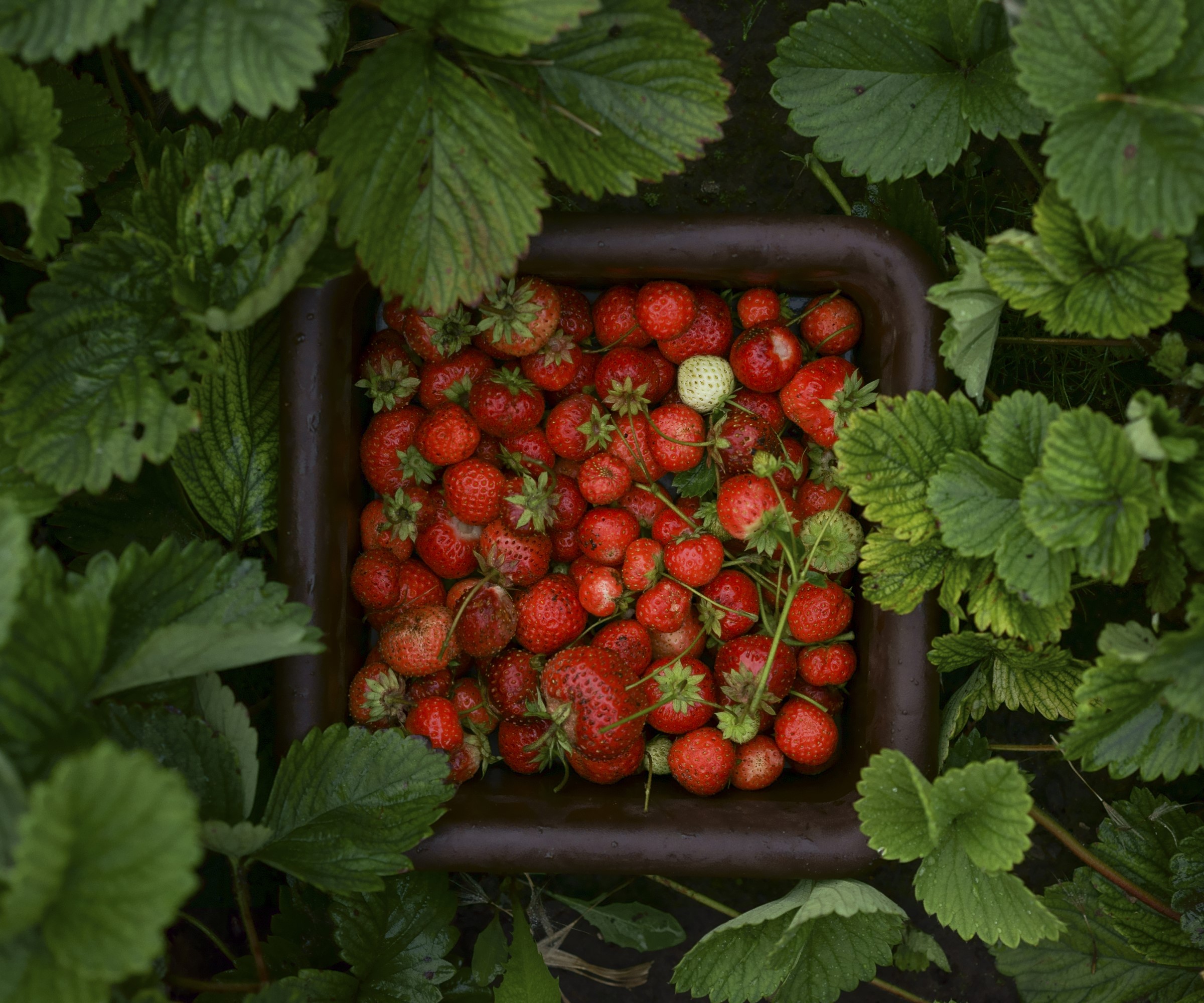
Strawberry pests can heavily affect your plant's harvests
What are the most common strawberry pests?
Unfortunately, for all gardeners that grow strawberries there are going to be pests that want to feast on your plants and reduce your strawberry harvest. The most common strawberry pests include the likes of slugs, strawberry root weevils, aphids, earwigs and sow bugs.
Christy Wilhelmi from Gardenerd adds that the tarnished plant bug and spittlebugs can also cause problems for strawberry growers. She adds: ‘Some gardeners experience beetles eating their strawberries too. If left unprotected, squirrels, rats and other larger animals will forage on strawberries if given the opportunity.
‘Holes in berries, and half-eaten berries dropped away from the strawberry patch are sure signs that marauders are pilfering your supply.’
The bad news is that many different parts of the strawberry plants are at risk from pests and all types of strawberry plants are at risk. For example, root weevil larvae feed on the roots, aphids attack the leaves and suck fluid out, while slugs eat fruit as well as foliage. If you grow strawberries indoors, that will reduce the range of pests that you could face.

Christy Wilhelmi has been a gardener for almost 30 years and specializes in small-space, organic vegetable garden design, consulting, and classes. She is an author of several gardening books, including Grow Your Own Mini Fruit Garden available on Amazon.
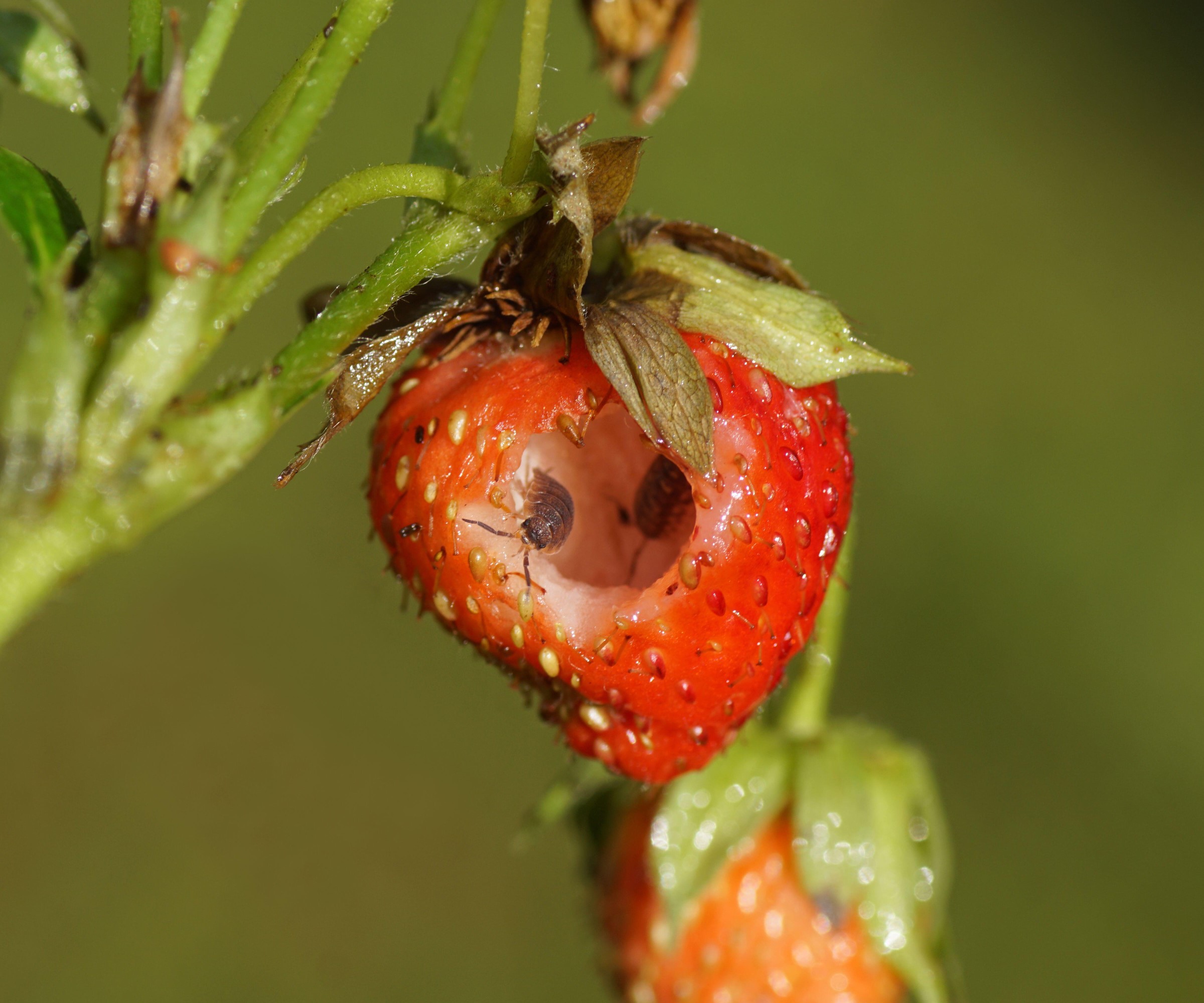
Holes in the fruits are a tell-tale sign of strawberry pests
What are the signs of pests on strawberry plants?
Dick Zondag, the former president and current Garden Doctor for Jung Seed, claims that ‘observing your plants is the best way’ to detect problems with strawberry pests. He cites the example: ‘Wilting may be a symptom and spittle bugs produce a substance that looks like someone spit on your plants.’
Spittlebugs do not kill a plant, but can stunt it as they feed on the stems and weaken the plant as a whole. An easy-to-identify foam tends to appear towards the base of the plants. A tarnished plant bug, however, will emerge in spring and feed on buds, blossoms, and young fruit. This causes fruit to stop maturing and a tell-tale sign of tarnished plant bugs is those unique mis-shapen fruits.
Slugs are often responsible for nibbling holes into fruits. Mary Jane Duford from Home for the Harvest claims they are easiest to observe at night in cool weather and the signs can be obvious, with trails of slime on the plants as well as ‘feeding damage’ on leaves on berries.
The presence of root weevils is not so simple to identify, unfortunately, as she warns: ‘While the larvae do the most damage, it is easier to see the damage from the adults. Adult root weevils feed on the out margins of leaves, leaving a distinct notched pattern.
‘Look for leaves with notched edges on your strawberry plants or nearby perennials like peonies. Notched leaf perimeters can indicate the presence of adult root weevils, which points to possible larval root damage from the same pest.’
Aphids may be small in size but an infestation can cause distortions in growth and yellowing strawberry leaves. These bugs are visible on the undersides of leaves, which is the common place they tend to cluster along with on plant stems.
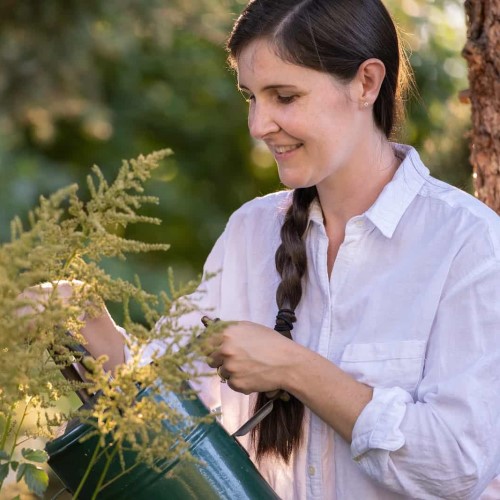
Mary Jane Duford is a gardening expert and founder of the gardening blog Home for the Harvest. Mary Jane is a Master Gardener-in-Training and a certified permaculture garden designer. Her gardening blog is visited by millions of readers each year, from the USA, UK, Canada, and around the world.
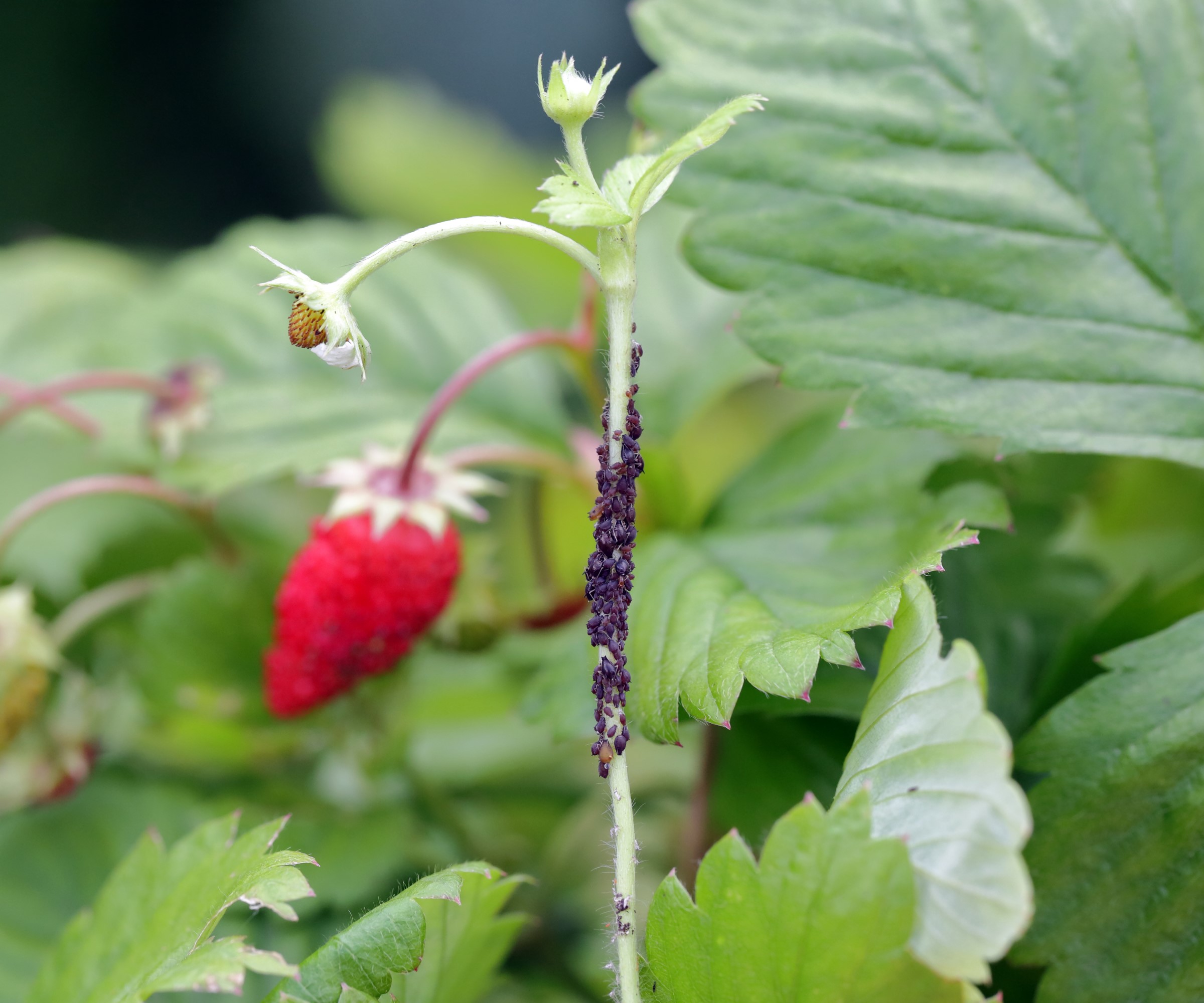
Aphids are common strawberry pests and often seen on stems
Controlling strawberry pests
If it is larger mammals such as squirrels or rats that are causing issues and stealing fruits, then you may need to opt for larger physical barriers to keep them out. Christy Wilhelmi recommends: ‘Deer fencing or bird netting placed over the tops of each strawberry bed will keep critters out. Use screws or hooks to secure the netting around the base of each bed to keep them from getting inside.’
Checking plants, blooms, and fruits frequently can indicate signs of pests. Monitor blooms for tarnished plant bugs in spring and for spittlebugs throughout the season. As tarnished plant bugs are hard to get rid of fully, the best precaution is to keep them away from your strawberry plants. They are prevalent on many common backyard weeds, such as dandelion and chickweed, so keep your yard weed-free during spring and consider covering strawberry plants with fine mesh or row covers to protect early blooms. Such covers can also guard against spittlebugs, while a simple jet of water from a hose can dislodge them or they can be wiped off by hand.
Mary Jane Duford advises that aphids are also ‘easy to spray off with water’ when they are seen in clumps. She adds: ‘You can use an organic insecticidal soap spray, but usually the little creatures can be destroyed simply by regularly spraying the leaf undersides and stems with a sharp stream of water.
‘If slugs are a problem, avoid planting your strawberries in shady, moist areas. Then take a flashlight out in the late evening and hand-pick and destroy any intruders.’
You can get insecticidal soap spray at Amazon to combat aphids and there are organic slug control methods, including using orange peel to deter pests. Slugs will be attracted to orange peel scattered around plants and that will allow you to collect them. Always clean strawberries harvested from plants that show signs of any pest presence before consuming.
The best way to control root weevils is to physically destroy the grubs and they can be hand-removed at night on small plants. Sticky tape or card – such as yellow sticky traps available at Amazon – around the base of larger plants can be used to get weevils at ground level. Parasitic nematodes that will feed on beetle larvae can also be applied in spring or summer to combat root weevils.
If there is sign of a root weevil problem, use crop rotation and avoid planting strawberries in that area the following season. Strawberries get less productive over time and often have a lifespan of three years, so utilize crop rotation by planting strawberries around the plot to avoid an existing root weevil infestation from damaging new plantings.
When planning a kitchen garden, using strawberry companion plants can help to protect the crop from some pests. Aliums, such as onions or garlic, emit a pungent smell that deters many pests, such as slugs and snails, so can offer benefits by being planted alongside strawberries. You can also utilize diatomaceous earth, a natural and powdery substance, by scattering it around plants as a way to deter aphids, slugs, earwigs, ants, and mites. You can get bags of Diatomaceous Earth at Amazon.
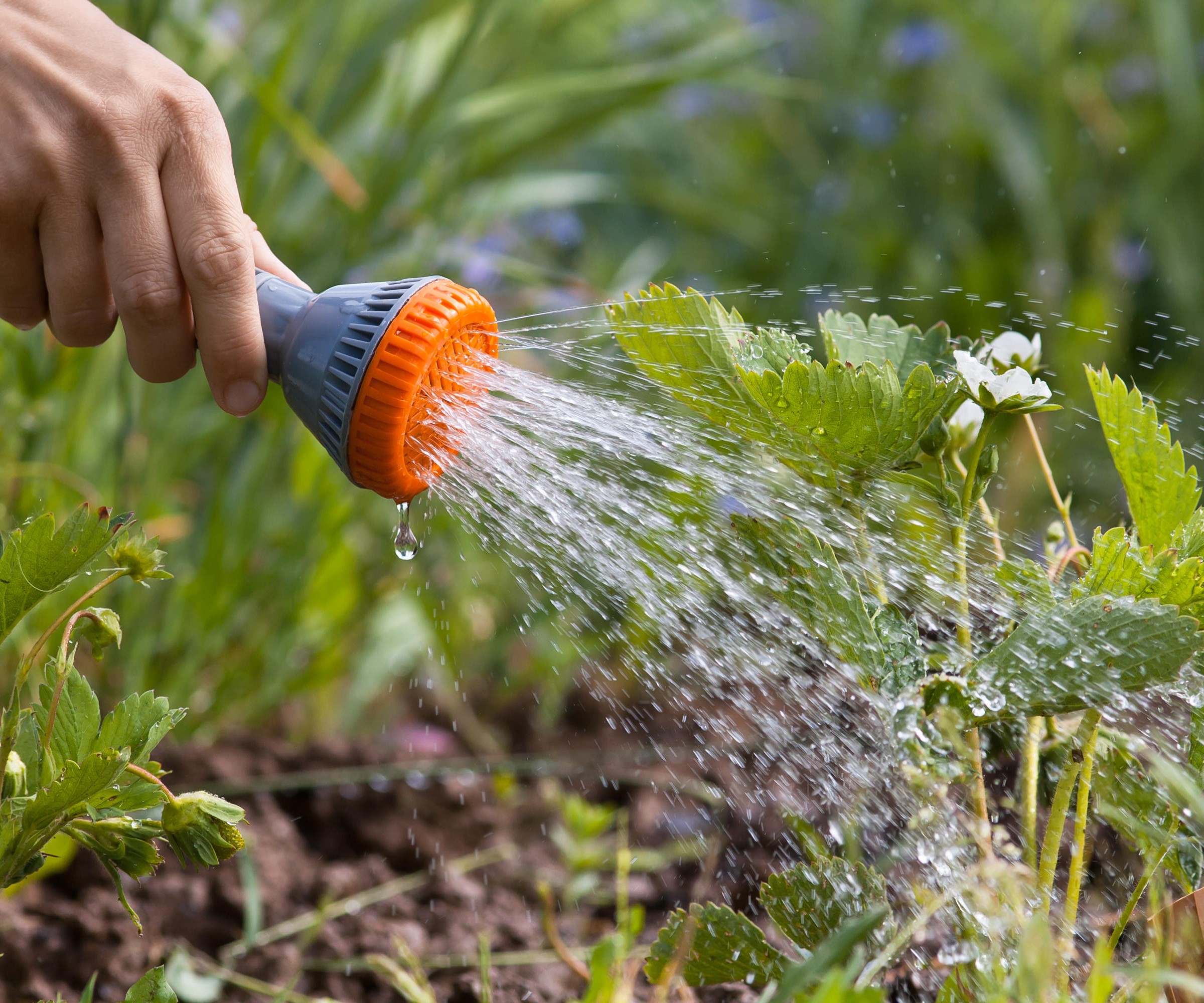
Spraying plants with a jet of water can dislodge pests like aphids or spittlebugs
There may be quite a list of potential strawberry pests, but don't let that deter you from growing them in your backyard. They are versatile and you can even grow strawberries in pots if you have no soil, making them suitable for decks, patios, or balconies. Remember to keep your eyes peeled for problems and implement plans to either deter the nasties or deal with them if they hit.
Sign up to the Homes & Gardens newsletter
Design expertise in your inbox – from inspiring decorating ideas and beautiful celebrity homes to practical gardening advice and shopping round-ups.

Drew’s passion for gardening started with growing vegetables and salad in raised beds in a small urban terrace garden. He has worked as a professional gardener in historic gardens and specialises in growing vegetables, fruit, herbs, and cut flowers as a kitchen gardener. That passion for growing extends to being an allotmenteer, garden blogger, and producing how-to gardening guides for websites. Drew was shortlisted for the New Talent of the Year award at the 2023 Garden Media Guild Awards.
-
 'Wick away the ick' – 6 things people with clean laundry rooms always do to make this hardworking space shine
'Wick away the ick' – 6 things people with clean laundry rooms always do to make this hardworking space shineThese tips on how to clean your laundry room will banish grime
By Seraphina Di Mizzurati Published
-
 Jennifer Aniston’s bedroom is a ‘goldmine of simple sumptuousness’ – it’s 2025’s version of quiet luxury and so easy to recreate
Jennifer Aniston’s bedroom is a ‘goldmine of simple sumptuousness’ – it’s 2025’s version of quiet luxury and so easy to recreateThe actress's unique space features James Mont-designed lamps and a raised bed inside a walnut plinth – but you can recreate its understated sophistication
By Megan Slack Published